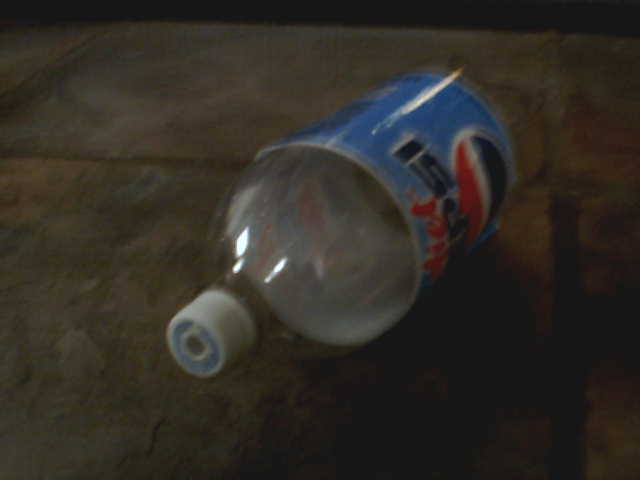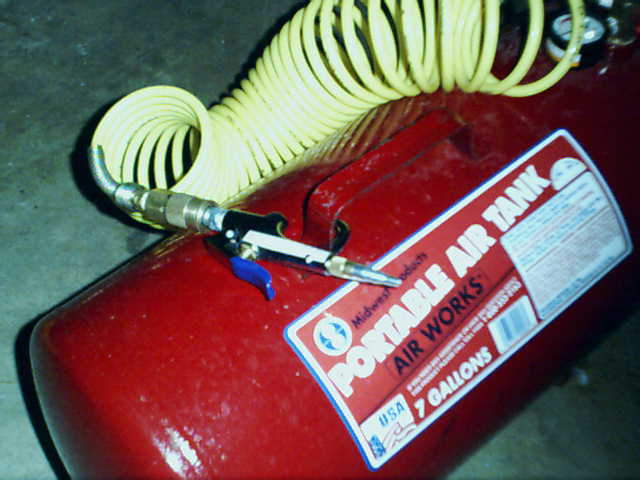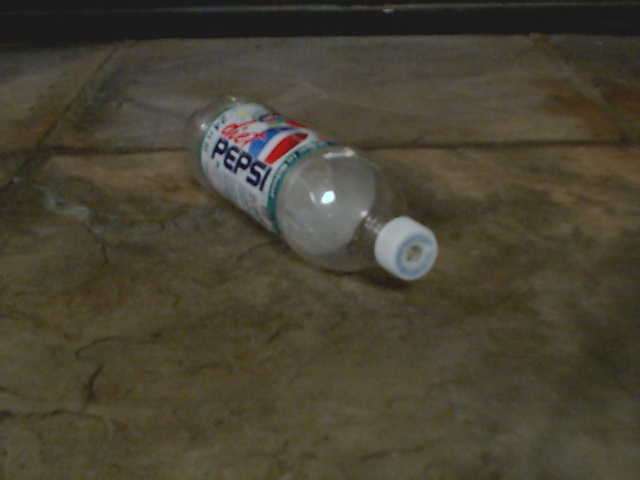The 'Pepsi Bottle Rocket' Page

Gutless Disclaimer
This web page contains information describing a potentially dangerous project. Children
under the age of 18, adults without prior knowledge of 'shop safety', and anyone who is
unfamiliar with chemicals and/or high pressure air and their potential dangers should NOT
attempt any of the things mentioned on this web page. If you build or attempt anything
described on this web page, it is at your own risk, and not mine, no matter what. This page
is for entertainment purposes only, and if you think you might be breaking any laws by doing
anything described herein, you'd better find out beforehand.
Some time ago I thought it would be cool to make a liquid fueled rocket out of a Pepsi Bottle.
As it turns out, there are 2 ways to do this. The first method is slightly dangerous, but the
second method is rather safe as long as you aren't too aggressive with air pressure.
Plastic 2 liter pepsi bottles work well because they have no "cap" on them, and the resulting
shape is quite aerodynamic. You can also peel off the label pretty easily. The resulting clear
plastic bottle will then 'light up' rather well at night if you use the 1st method, making for
a cheap fireworks display.
METHOD #1: The liquid fueled pepsi bottle rocket
- Drill 1/4" to 3/8" hole in center of the bottle cap for a plastic 2 liter pepsi bottle
- Use equal amounts of bleach and hydrogen peroxide solution (the diluted stuff
you get at the grocery store, not the concentrated stuff, ok?) to produce oxygen
gas. Alternately you can use an O2 tank if you have one. You'll need 1/4 cup of
each (about 50ml for metric folks), mixed INSIDE the 'rocket' bottle.
- Put about a teaspoon (10ml for metric folks) of isopropyl alcohol in the rocket
bottle (that's filled with O2 gas) and swish it around really good so it coats the
inside (this will help protect the plastic).
- Cap the bottle (use the one with the hole, ok?) and invert it. You'll either need
to glue 'legs' onto the bottle, or else build some kind of stand, for the next part to
work correctly.
- Using a fireplace match (something LONG, right?) ignite the rocket by allowing the
flame to poke up into the inside of the hole. You could alternately use an electric
rocket motor starter, or glue some resistor wire to a match head to make your OWN
starter (a 10 ohm 1/4 watt resistor wrapped about a match head, with 24 volts applied,
is another way to do this, or even a short length of steel wool similarly prepared).
Wear hand and eye protection, just in case, ok?
A liquid fueled pepsi bottle rocket should fly at least 30 feet into the air on a good day,
glowing white hot for about 1.5 seconds. Not bad for a cheap model rocket. I've flown
a few of them, and I found them interesting, at the least.
METHOD #2: The pressurized air and water pepsi bottle rocket
- Drill 1/4" to 3/8" hole in center of the bottle cap for a plastic 2 liter pepsi bottle.
For this particular rocket, you have to be EXACTLY in the center, and the hole should be VERY
CLEAN and PRECISELY ROUND. Use a de-burring tool to get the extra plastic off, and then melt
the edges slightly with a match or candle flame (or maybe one of those 'pilot light' lighters).
- You will need a tank of pressurized air and some kind of valve and hose assembly. If you
use a hand-held air nozzle (the kind you blow dust off of things with) use one with a tapered
end that doesn't leak air around the sides. The nozzle I have is rated to 90 psi so that seems
like a good PRESSURE LIMIT to stay under, as I've not 'hydro tested' the bottles at higher
pressures.
- Fill the bottle with an approrpiate amount of water, based upon the air pressure you use.
For 40 psi, use 1/3 to 1/2 full of water. For 60 psi, use 1/2 to 2/3 full of water. For
80 psi, use 2/3 to 3/4 full of water. For larger hole sizes, you can use more water for a given
air pressure because the thrust will be higher, but you should be aware that if the pressure
drops too low the water will not all be expelled, resulting in a dropping bottle partially full
of water (and I wouldn't want it landing on anything important). An empty bottle floats down and
tumbles in an interesting way. A bottle with water in it comes crashing down (maybe on your head)!
- Cap the bottle, then insert the air nozzle into the cap. Try to get a good seal if you can,
but if you don't, just be advised you'll get wet. Invert the bottle, pointing it straight up
and over your head (safer this way) by the cap and the ridge just below it (or above it, now).
THEN, inject the air with the air nozzle. If your air tank is at 90 psi or below, just wait
until the bubbles stop (it takes about 1 second, typically, to do this), and then LET GO!

WARNING: high pressure air could make a pepsi bottle DETONATE. Wear hand and eye
protection if you do this, and expect that the bottle will detonate if you exceed 90 psi.
There is no guarantee that staying under 90 psi will prevent detonation, however. Shaking
a pepsi bottle will pressurize it to around 50 or 60 psi by my estimate, so it's capable of
handling quite a bit of pressure. But 90 psi is clearly above the maximum you'd expect from
a pepsi bottle in normal circustances, and soda bottles in general have been known to detonate
when left inside of a car on a hot day with the sun shining on them.
NOW, with the 2nd gutless disclaimer out of the way, after testing the 2 liter version of this
rocket in flight, I can verify that the calculations (below) that show its altitude peak at
between 70 and 100 feet are relatively accurate, but of course, your flight tests may vary.
I have ALSO successfully tested a 24 oz bottle half filled with water. It accelerated for a
good 1-1/2 seconds, and I lost track of it immediately and for several seconds following launch,
after which I noticed it tumbling back down (from straight up) at a height of about 25 or so feet
above my head. So it's quite possible that the bottle exceeded 45 feet during the flight. This
bottle was half full of water (to reduce it's total flight) but was pressurized to about 80 psi.
As it had no 'fins' this was actually a better choice (see below). The hole diameter was slightly
larger than 1/4", which ended up giving it a rather tremendous (but short) acceleration period.
This is a photograph of the 'test bottle'. Estimated peak altitude on maiden flight: 45 feet.

And, here are some simple calculations and observations, based upon a slightly greater than 1/4"
diameter hole (which is what I have - diameter must be around .31 inches for 0.5 cm^2), 90 psi,
and a 2/3 full 2 liter bottle.
- Total water volume: 1.3 liters (1300 grams)
- Total air volume (compressed): 0.7 liters
- Total air volume (uncompressed): 4.2 liters
- Specific flow energy (pressure * specific volume): 6200 (cm)
- Initial velocity of liquid at 90psi: 35 m/sec, or about 85+ mph
- Net impulse on takeoff: 1750 g-cm/sec (appx 0.5 cm^2 hole)
- Gravitational acceleration on takeoff: 0.35 G's
- Estimated impulse half way through fuel: 875 g-cm/sec
- Estimated mass half way through fuel: 650 grams
- Estimated acceleration half way through fuel: 0.35 G's
- Theoretical mass at end of flight:- ~100 grams
- Theoretical impulse at end of flight: ~600 g-cm/sec
- Theoretical acceleration at end of flight: 6 G's
- Estimated average acceleration over entire flight: 0.4 G's
- Measured time to empty bottle - 3 sec (avg ~430 g/sec)
- Estimated Peak Velocity: 12 m/sec (appx 30 mph)
- Maximum height at end of acceleration: 18 meters (60 feet)
- Maximum attainable height: approximately 70 feet
For the 24 oz bottle (appx 700 ml) filled half way, pressurized to 90 psi with a slightly greater
than 1/4" hole, here are the following observations and calculations:
- Total water volume - 350 ml (350 grams)
- Total air volume (compressed): .35 liters
- Total air volume (uncompressed): 2.1 liters
- Specific flow energy: 6200 (cm)
- initial velocity of liquid at 90 psi: 35 m/sec
- Net impulse on takeoff: 1750 g-cm/sec
- Gravitational accelration on takeoff: 4 G's
- Estimated time of average acceleration: 1.5 seconds
- Estimated Peak Velocity: 58 m/sec (appx 130 MPH)
- Maximum height at end of acceleration: 11 meters (35 feet)
With these 'pepsi bottle rockets', it's not so much "how fast do I go" because once you run
out of water, the bottle has no momentum at all (weighing so little) so that the air quickly
slows it down. Rather, it's how LONG you can continue accelerating effectively. An ideal
balance exists between fuel (water level) and hole size. Too much fuel and pressure drops
too low at the end of the flight, causing the water to 'drain out' instead of spray out.
Too small of a hole and the acceleration is too small. Too large of a hole, and the fuel
runs out too quickly. In this example, we double the hole area (slightly over 3/8" diameter).
- Total water volume: 1.3 liters (1300 grams)
- Total air volume (compressed): 0.7 liters
- Total air volume (uncompressed): 4.2 liters
- Specific flow energy (pressure * specific volume): 6200 (cm)
- Initial velocity of liquid at 90psi: 35 m/sec, or about 85+ mph
- Net impulse on takeoff: 3500 g-cm/sec (appx 1.0 cm^2 hole)
- Gravitational acceleration on takeoff: 1.7 G's
- Estimated impulse half way through fuel: 1750 g-cm/sec
- Estimated mass half way through fuel: 650 grams
- Estimated acceleration half way through fuel: 1.7 G's
- Theoretical mass at end of flight:- ~100 grams
- Theoretical impulse at end of flight: ~1200 g-cm/sec
- Theoretical acceleration at end of flight: 12 G's
- Estimated average acceleration over entire flight: 2.0 G's
- Measured time to empty bottle - 1.5 sec
- Estimated Peak Velocity: 29.4 m/sec (appx 63 mph)
- Maximum height at end of acceleration: 22 meters (72 feet)
- Maximum attainable height: approximately 82 feet
So in this case, doubling the area of the hole gives you slightly more altitude, and a shorter
acceleration (not counting wind resistance). But somewhere is probably the 'maximum height' value
for an 'ideal hole size'. If you reduce the area to 0.7 cm^2 (84% of previous diameter), you get
an average acceleration of 1.0 G's for approximately 2.1 seconds, for a maximum height at the end of
acceleration of 21.6 meters, just slightly smaller than the previous one. If you increase the area
to 1.3 cm^2 (114% of previous diameter) you end up with about 1.1 seconds of acceleration at an
estimated average of 3.8 G's of acceleration. This yields in a maximum height at the end of
acceleration of 22.5 meters. But 1.5 cm^2 (122% of previous diameter) gives you an average
acceleration of around 4.3 G's for the flight, but for only 1 second, with a maximum height at
the end of accelration of only 21 meters, and it goes down from there. And because mass is so
small, wind resistance takes over near the end of the flight, most likely causing the peak height
to be lower than expected. In short, smaller velocities at the end of the flight are probably
more practical than trying to rely on inertia. Given this, peak height after acceleration becomes
the most important determining factor on the maximum height attained during the flight.
FLIGHT AERODYNAMICS
One of the first major problems in the design is the tendency for the bottle to "go wild" without
some kind of aerodynamic stabilizer. The "long skinny" nature of the 24 oz bottle made it fly very
well when less than half full of water, but when it was 3/4 full, it "went wild" and plowed straight
into the ground. The 2 liter bottle wasn't much better when 3/4 full, and actually did a complete
loop while airborne, but near the end of its flight (and very near the ground) it rapidly righted
itself and shot about 10 feet straight up.
Rockets are (by nature) quite unstable, similar to holding a broom on the end of your finger. Since
there is only a single "engine" and no controls, the aerodynamics of the rocket must stabilize it.
The easiest way to accomplish this would be to attach some kind of 'fins' to the rocket, or simply
limit the total amount of fuel in it. As it turns out, filling the bottle HALF WAY with water, and
using a smaller diameter hole (0.5 cm^2), gives you the following characteristics:
- Total water volume: 1.0 liters (1000 grams)
- Total air volume (compressed): 1.0 liters
- Total air volume (uncompressed): 6.0 liters
- Specific flow energy (pressure * specific volume): 6200 (cm)
- Initial velocity of liquid at 90psi: 35 m/sec, or about 85+ mph
- Net impulse on takeoff: 1750 g-cm/sec (appx 0.5 cm^2 hole)
- Gravitational acceleration on takeoff: 0.75 G's
- Estimated impulse half way through fuel: 1170 g-cm/sec
- Estimated mass half way through fuel: 500 grams
- Estimated acceleration half way through fuel: 1.3 G's
- Theoretical mass at end of flight:- ~100 grams
- Theoretical impulse at end of flight: ~900 g-cm/sec
- Theoretical acceleration at end of flight: 9 G's
- Estimated average acceleration over entire flight: 1.4 G's
- Measured time to empty bottle - 2 sec (avg ~500 g/sec)
- Estimated Peak Velocity: 27 m/sec (appx 60 mph)
- Maximum height at end of acceleration: 27 meters (88 feet)
- Maximum attainable height: approximately 100 feet
So it looks as though USING LESS WATER (which gives you a higher thrust to weight ratio) may be the
best method when the hole size is relatively small, AND there are no 'aerodynamic stabilizers' on
the rocket to keep it from going 'wild'. According to "The Hitchhiker's Guide to Model Rocketry"
(see link below) you have to keep the 'center of gravity' behind the 'center of pressure for the
rocket to be stable. So it explains why "less fuel" flies more stable, because the center of
gravity is significantly LOWER than the center of pressure.
Of course, if you want to add MORE stability, you can put 'fins' on the rocket. This will basically
help keep the engine pointing down, and the top of the rocket pointing up, by adding a small amount
of 'drag' to the bottom of the rocket. Alternately, you can add a pointed 'nose cone' which would
not only improve the aerodynamics, but would have the added benefit of moving the center of gravity
DOWN, with respect to the 'center of air pressure', and thereby stabilize the rocket even more.
And fins will work best if they also cause the rocket to spin (like a bullet in a rifle).
But you still need rapid initial acceleration for this to work properly, as I've found out the
hard way - when the G force is too low initially, the aerodynamics won't help keep the rocket from
going wild, because the "motor's" inherent instability (no hole is perfect, plus turbulent water flow
causes inconsistency in thrust direction with all of that splashing water) becomes too significant
of a factor when compared to the affect of air flow. So you need to get the thing going fast as
soon as you can, or else the rocket will start wobbling in the air, and maybe even do a complete
loop (as my 3/4 full bottle did).
LINKS
The Hitchhiker's Guideto Model Rocketry
The 'rocketry.org' web site
archived www.rocketry.org
A Wikipedia page on water rockets
Water Rockets dot com
Instructables dot com Soda Bottle Water Rocket
A recently submitted link, Model Rocket Maintenance and Technology
I have also seen a few videos on the 'intarwebs' showing other people using various soda bottle rockets,
rockets made from steel soup cans, and so forth. Basically, ANY pressure vessel with some kind of a nozzle
can be turned into a rocket. On Mythbusters they
turned a water heater into a rocket [in a spectactular and dangerous manner]. Care should always be taken
to avoid being hurt by explosion. (gutless disclaimer, yeah)
I have seen suggestions online for 'hydro testing' your pressure vessel by filling it completely with water,
then applying pressure to an amount that is 50% more than you expect to use for flight, to make sure that the
pressure vessel does not leak, and does not explode. If it DOES explode during the 'hydro test' when completely
filled with water, the damage from flying shrapnel would be minimized, since pressure drops VERY fast when it's
basically "all water". But keep in mind that 'flying shrapnel' IS a possibility here. Safety is important.
(It never hurts to wear some kind of eye and hand/arm protection)
Somewhat MORE recently, a water rocket may have come
dangerously close to an aircraft. Just like problems with remote controlled aircraft in general, these things should NOT
be flown ANYWHERE near a designated flight path or airport. The downside of 'no responsibility' from flying any kind of
aircraft (including rockets) is, unfortunately, GOVERNMENT REGULATION, bad press, and actual injuries [or worse].
So, please, FLY responsibly!



